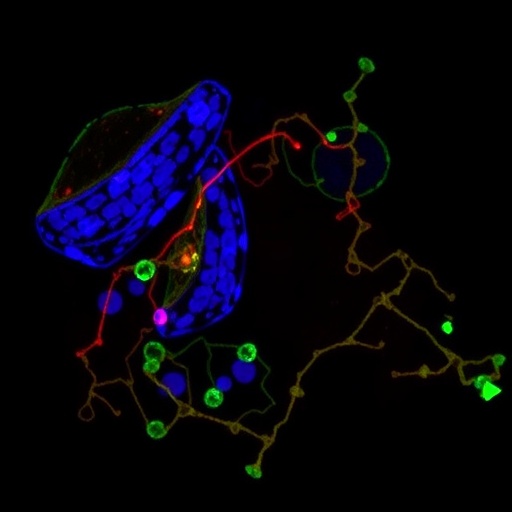In a groundbreaking study published in Reproductive Sciences, researchers have unveiled significant insights into the complex interplay between hypoxia and trophoblast cell function. The investigation, led by Zhang et al., reveals how altered expression of calpastatin under conditions of low oxygen levels can orchestrate crucial changes in mitochondrial dynamics associated with endoplasmic reticulum membranes within trophoblasts. This discovery could have profound implications for our understanding of placental development and dysfunction, particularly in conditions such as preeclampsia and fetal growth restriction.
Trophoblast cells, which form the outer layer of the placenta, play an essential role in implantation, nutrient transport, and the maintenance of a healthy pregnancy. They are particularly sensitive to variations in oxygen levels, as fetal development is highly dependent on a well-regulated placental environment. Hypoxia, commonly encountered in early pregnancy, triggers various physiological adaptations necessary for successful implantation and placental formation. However, the underlying molecular mechanisms driving these adaptations have remained largely elusive until now.
The study demonstrates that calpastatin, an inhibitor of calpain proteases, exhibits altered expression patterns in response to hypoxic conditions. This is particularly noteworthy due to calpain’s involvement in various cellular processes, including apoptosis, cell migration, and differentiation. By regulating calpain activity, calpastatin serves as a key player in maintaining balanced trophoblast function, ensuring that the cells can effectively respond to stressors like hypoxia.
When subjected to hypoxic conditions, trophoblast cells display an intricate response that involves mitochondrial adaptation. The study highlights how these changes are regulated through mitochondria-associated endoplasmic reticulum membranes (MAMs), which play a crucial role in cellular signaling and metabolism. MAMs facilitate communication between the mitochondria and the endoplasmic reticulum, two organelles critical for cellular health and function.
Zhang and colleagues utilized a series of in vitro experiments to explore how calpastatin expression is modulated by hypoxia. Their findings indicate that increased hypoxic stress leads to a significant upregulation of calpastatin, which in turn inhibits calpain activity. This inhibition appears essential for protecting trophoblast cells from premature apoptosis, thereby promoting cell survival under challenging conditions.
Moreover, the team employed advanced imaging techniques to visualize the interaction between mitochondria and the endoplasmic reticulum in response to hypoxia. They reported that under these low oxygen conditions, MAMs are dynamically altered, leading to changes in calcium signaling and lipid metabolism crucial for trophoblast function. These insights suggest that the hypoxic environment profoundly influences the physical and functional relationship between these organelles.
Importantly, hypoxia-induced alterations in calpastatin expression could serve as a significant biomarker for assessing placental health. Understanding how these changes manifest could provide clinicians with valuable tools for diagnosing and managing pregnancy-related complications. Moreover, the researchers propose that targeting calpastatin could offer new therapeutic avenues to enhance trophoblast resilience during hypoxic episodes.
As the study progresses, the researchers are also keen on exploring the long-term consequences of altered calpastatin levels on trophoblast differentiation and function. They aim to extend their findings beyond the confines of in vitro models to in vivo systems, hoping to validate their results within the context of pregnancy and placental development.
With their novel insights into the molecular underpinnings of trophoblast biology, Zhang et al. have laid a foundation for future research aimed at elucidating the intricate mechanisms governing placental health. Considering the global rise in pregnancy complications, their findings could not only enhance our understanding of placental biology but also contribute to developing innovative strategies to mitigate risks during pregnancy.
Ultimately, the correlation between hypoxia, calpastatin expression, and trophoblast function presents a compelling narrative in reproductive science. It underscores the critical importance of cellular adaptation in maintaining pregnancy under varying environmental conditions. As research progresses, the hope is that this knowledge will translate into meaningful clinical advancements that enhance maternal and fetal health.
In summary, Zhang and colleagues have provided compelling evidence that underscores the essential role of calpastatin in regulating trophoblast cell function under hypoxic conditions. Their findings illuminate the complex interplay between mitochondrial health and placental development, paving the way for future exploration and potential therapeutic interventions targeting these pathways.
This study marks a significant stride in the field of reproductive biology, promising to reshape our understanding of placental adaptation to hypoxia and its implications for pregnancy outcomes. As scientists delve deeper into these mechanisms, the potential for breakthroughs in preventing and treating placental-related pregnancy complications grows ever more tangible.
As awareness of these findings spreads within the scientific community and beyond, there is a strong potential for this research to gain traction amongst both scholars and healthcare practitioners. The path towards a deeper understanding of placental function and its vulnerabilities is critical, offering hope for future advancements in maternal-fetal medicine.
The revelations by Zhang et al. not only contribute to fundamental biological knowledge but may also redefine approaches to therapeutic strategies for enhancing trophoblast resilience in the face of hypoxia.
The future of pregnancy science looks brighter as the implications of this research unfold, potentially influencing clinical practices and outcomes for mothers and their babies around the world.
Subject of Research: Hypoxia and Trophoblast Cell Function Regulation
Article Title: Altered Expression of Calpastatin by Hypoxia Regulates Trophoblast Cell Function through Mitochondria Associated Endoplasmic Reticulum Membranes
Article References:
Zhang, C., Jiang, J., Kong, H. et al. Altered Expression of Calpastatin by Hypoxia Regulates Trophoblast Cell Function through Mitochondria Associated Endoplasmic Reticulum Membranes. Reprod. Sci. (2025). https://doi.org/10.1007/s43032-025-01995-4
Image Credits: AI Generated
DOI:
Keywords: Hypoxia, Calpastatin, Trophoblast, Mitochondria, Endoplasmic Reticulum, Pregnancy, Placenta, Cellular Adaptation, Reproductive Science.




